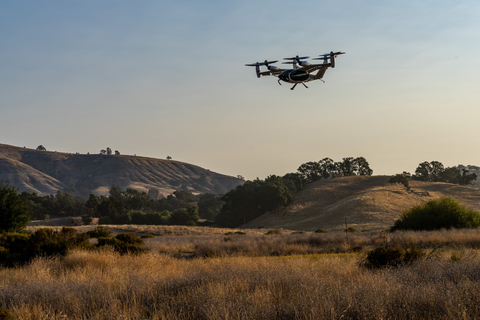Joby Confirms Revolutionary Low Noise Footprint Following NASA Testing
Joby Aviation (NYSE:JOBY) successfully completed acoustic testing with NASA, demonstrating its pre-production aircraft's low noise profile. The aircraft achieved a sound level of 45.2 dBA at 1640 feet during flight, significantly quieter than traditional aircraft, and below 65 dBA during take-off and landing, comparable to normal conversation. This achievement positions Joby to enhance urban air mobility and aims for a commercial launch of its aerial ridesharing service in 2024, focusing on reducing urban congestion with its environmentally friendly technology.
- Successfully completed acoustic testing with NASA, showcasing low noise levels which enhance urban air mobility potential.
- Achieved an acoustic reading of 45.2 dBA at 1640 feet, significantly lower than traditional aircraft noise, and measured below 65 dBA during take-off and landing.
- None.
Insights
Analyzing...

(Photo: Business Wire)
Following analysis of the data obtained over two weeks of testing as part of NASA’s Advanced Air Mobility National Campaign, Joby’s aircraft was shown to have met the revolutionary low noise targets the Company set for itself.
The aircraft registered the equivalent of 45.2 A-weighted decibels (dBA) from an altitude of 1640 feet (500 meters) at 100 knots airspeed, a sound level which Joby believes will barely be perceptible against the ambient environment of cities.
NASA engineers also measured the aircraft’s acoustic profile during planned take-off and landing profiles to be below 65 dBA, a noise level comparable to normal conversation, at a distance of 330 feet (100 meters) from the flight path.
“We’re thrilled to show the world just how quiet our aircraft is by working with NASA to take these measurements,” said
“With an aircraft this quiet, we have the opportunity to completely rethink how we live and travel today, helping to make flight an everyday reality in and around cities. It’s a game-changer.”
All measurements were conducted using NASA’s Mobile Acoustics Facility, with more than 50 pressure ground-plate microphones placed in a grid array at Joby’s Electric
To measure the Joby aircraft’s acoustic footprint during overhead flight, it flew over the grid array six times at an airspeed of 100 knots and a low altitude to measure as much of the aircraft’s noise above the background ambience as possible. Data recorded from the field of omni-directional microphones was then processed by NASA into an “acoustic hemisphere,” representing the sound emission in all directions below the aircraft at a 100 ft radius. Joby then applied standard processing techniques for spherical spreading and atmospheric attenuation, resulting in an average free-field overhead flight acoustic reading of 45.2 dBA at 1640 feet (500 meters).
Joby also conducted more than 20 take-off and landing tests above the grid array, using a variety of acceleration rates and climb angles to allow NASA to capture acoustics representative of likely operational procedures. This data will be used to adjust flight software and take-off and landing procedures for further low-noise optimization.
From day one, the Joby aircraft was designed with acoustics in mind, with the number of propellers and blades, blade shape and radius, tip speeds, and disk loading of the aircraft all selected to minimize its acoustics footprint and improve the character of the sound produced. Each of the six propellers can also individually adjust its tilt, rotational speed, and blade pitch to avoid blade-vortex interactions that contribute to the acoustic footprint of traditional helicopters.
More details regarding procedures and measurements will be released by both Joby and NASA in technical papers to be presented at industry conferences this summer.
Joby’s piloted five-seat eVTOL aircraft can carry four passengers at speeds of up to 200 mph, with a maximum range of 150 miles on a single charge and zero operating emissions. With more than 10 years of development and over a thousand flight tests completed, Joby is targeting the launch of its aerial ridesharing service in 2024.
ABOUT
Forward Looking Statements
This press release contains “forward-looking statements” within the meaning of the “safe harbor” provisions of the Private Securities Litigation Reform Act of 1995, including but not limited to, statements regarding the development and performance of our aircraft including our initial plant capacity and regulatory outlook; our business plan, objectives, goals and market opportunity; and our current expectations relating to our business, financial condition, results of operations, prospects and capital needs. You can identify forward-looking statements by the fact that they do not relate strictly to historical or current facts. These statements may include words such as “anticipate”, “estimate”, "expect”, “project”, “plan”, “intend”, “believe”, “may”, “will”, “should”, “can have”, “likely” and other words and terms of similar meaning in connection with any discussion of the timing or nature of future operating or financial performance or other events. All forward looking statements are subject to risks and uncertainties that may cause actual results to differ materially, including: our limited operating history and history of losses; our ability to launch our aerial ridesharing service and the growth of the urban air mobility market generally; our plans to operate a commercial passenger service beginning in 2024; the competitive environment in which we operate; our future capital needs; our ability to adequately protect and enforce our intellectual property rights; our ability to effectively respond to evolving regulations and standards relating to our aircraft; our reliance on a third-party suppliers and service partners; uncertainties related to our estimates of the size of the market for its aircraft and future revenue opportunities; and other important factors discussed in the section titled “Risk Factors” in our Annual Report on Form 10-K, filed with the
View source version on businesswire.com: https://www.businesswire.com/news/home/20220510005429/en/
Investors: investors@jobyaviation.com
+1-831-201-6006
Media:
press@jobyaviation.com
Source:







